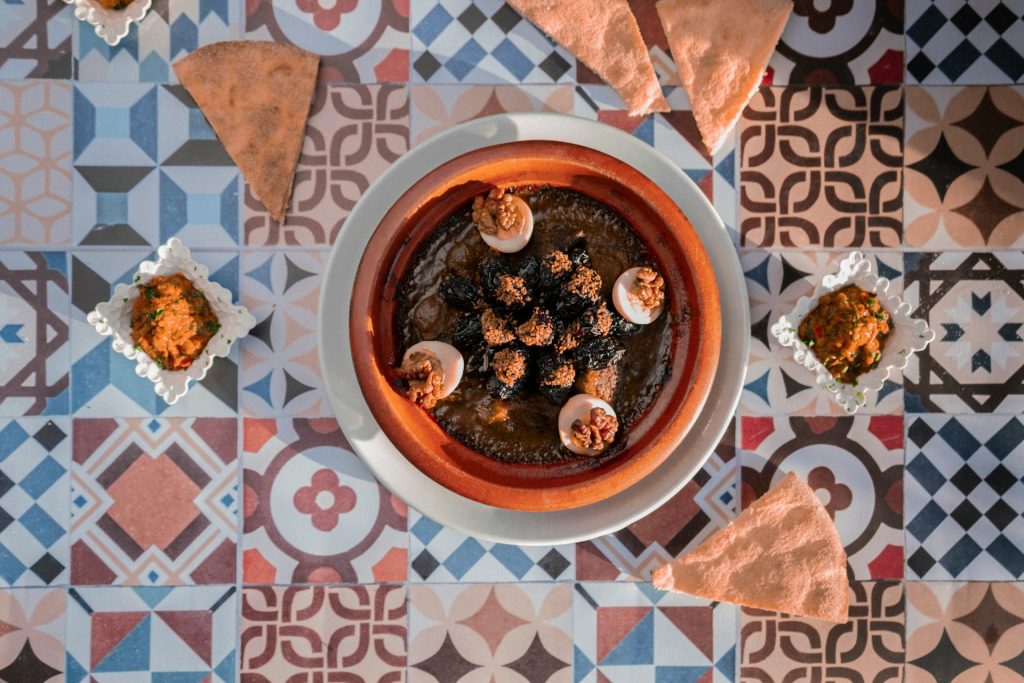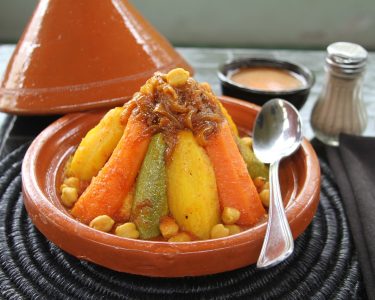Moroccan cuisine is anything but ordinary. It’s an exciting blend of flavors—spicy, sweet, tangy, and aromatic—that come together to create dishes that are not only delicious but also unforgettable. The country’s culinary tradition draws on influences from North Africa, the Mediterranean, and the Arab world, creating a food culture that is both rich and diverse. If you’re planning a trip to Morocco, the street food and local delicacies should be at the top of your to-do list.

While it’s tempting to dine at high-end restaurants, those who know Moroccan food best recommend exploring the vibrant Medinas—bustling markets where the true essence of Moroccan cuisine comes to life. Fez, Marrakech, and Essaouira are the top cities for experiencing this street food scene, offering countless stalls packed with tempting options. Whether it’s a savory tagine or a sweet, honey-coated treat, the Medinas come alive with the smells and tastes of traditional Moroccan spices after the sun goes down. Here are five dishes you simply cannot miss on your culinary journey through Morocco.
1. Harira: The Spiced Soup That Warms the Soul
Harira is more than just a soup in Morocco—it’s a symbol of comfort and tradition. This hearty soup is made with a flavorful base of tomatoes, chickpeas, lentils, and a medley of Moroccan spices. Although it’s especially popular during Ramadan, when it’s often served to break the fast, Harira can be enjoyed year-round. The ingredients meld together to create a rich, comforting dish that will linger in your memory long after you’ve left Morocco. It’s often accompanied by dates or sweet pastries, providing a perfect balance of flavors.
2. Tagine: The Slow-Cooked Moroccan Classic
Named after the clay pot in which it’s cooked, tagine is a Moroccan stew that showcases the country’s most prized spices and ingredients. A tagine can be made with a variety of meats like lamb, chicken, or beef, paired with vegetables, dried fruits like apricots, and preserved lemons. The slow-cooking process allows the flavors to meld together, producing a dish that is incredibly tender and aromatic. Served with khobz (Moroccan bread), this dish is a must-try, whether you opt for a beef tagine with prunes or a fish tagine spiced to perfection. The flavors will transport you straight to the heart of Moroccan kitchens.
3. Moroccan Couscous: The Staple of Every Gathering
Moroccan Couscous is a dish that goes beyond its simple appearance. It’s a beloved Moroccan entrée made from steamed semolina grains, typically topped with a flavorful mix of vegetables and either lamb or chicken. What makes Moroccan couscous special is how it’s infused with the country’s distinctive spices, giving it a rich, warm flavor that pairs perfectly with the hearty toppings. It’s often served during special occasions or family gatherings, making it both a celebratory and everyday dish. Locals traditionally eat couscous by hand, a testament to the communal aspect of Moroccan dining. If you find yourself in the Medina, don’t miss the chance to experience couscous the authentic way.
4. Chebakia: A Sweet Treat with a Crunch
Morocco’s love for sweets is embodied in chebakia, a traditional dessert that is as beautiful as it is tasty. These flower-shaped pastries are fried until golden and then coated in honey and sprinkled with sesame seeds. Chebakia is commonly eaten during Ramadan but is enjoyed throughout the year. The combination of crunchy, sticky sweetness is something you won’t easily forget. It’s a dessert that perfectly encapsulates the Moroccan approach to food—blending flavors and textures in a way that is both satisfying and unexpected.
5. Bastilla: A Fusion of Sweet and Savory
Bastilla (or pastilla) is one of Morocco’s most luxurious dishes, known for its complex blend of flavors and textures. Traditionally made with pigeon meat, it’s often prepared with chicken in modern versions. This savory pie is encased in layers of thin, flaky pastry and filled with a mixture of meat, eggs, and almonds, all seasoned with Moroccan spices. What sets Bastilla apart is the dusting of powdered sugar and cinnamon on top, creating an exquisite balance between sweet and savory. Typically served as an appetizer during celebrations, Bastilla is a dish that represents the fusion of flavors that defines Moroccan cuisine. For first-timers, it’s a must-try that offers a true taste of Morocco’s culinary depth.
A Journey Through Morocco’s Culinary Landscape
Moroccan cuisine is a vibrant tapestry of flavors, textures, and aromas, drawing from a deep cultural history and an array of regional influences. Exploring the street food stalls of Morocco’s Medinas allows you to experience the country’s culinary tradition in its purest form. From the comforting warmth of Harira to the sweet crunch of Chebakia, each dish tells a story and offers a window into Moroccan life.
Fez, Marrakech, and Essaouira, in particular, provide the perfect backdrop for discovering the best of Moroccan street food. As you wander through these bustling markets, you’ll be drawn in by the smells of spices, slow-cooked meats, and freshly baked bread. Be sure to visit after dark, when the Medinas truly come to life, and don’t be afraid to indulge in long, leisurely meals like the locals do.
In Moroccan culture, food is not just sustenance but a celebration. Meals are savored over time, with multiple courses and plenty of time to relax and enjoy the company of friends and family. By embracing the traditional flavors of Morocco, you’ll find that every bite is a new adventure.
Conclusion: Taste the Essence of Morocco
The magic of Moroccan food lies in its diversity and its ability to blend contrasting flavors into something harmonious and unforgettable. Whether it’s the savory layers of a Bastilla, the robust spices of a Tagine, or the sweetness of Chebakia, Moroccan cuisine will captivate your taste buds and leave you yearning for more. Make sure to explore beyond the fancy restaurants and dive into the vibrant street food scene of the Medinas. Only there will you truly discover the heart of Moroccan culinary tradition.

